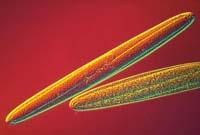Bacteria with thousands of genomes

Most bacteria have a single genome, while human cells have two and three or four plants. Because the bacteria Epulopiscium, which inhabits the intestine of a fish, has more than 200,000 copies. Therefore, he has easily exceeded the record of the bacteria he previously considered with more genomes: Buchnera aphidicola bacteria with 120 genomes.
Epulopiscium is a giant bacteria. It can measure 600 micrometers side by side and can be seen at a glance. Escherichia coli, for example, the bacteria that inhabits the human intestine, has a micrometer in length; a million E. coli enter the place that occupies an Epulopiscium.
It is such a large bacterium that it has few predators. But normally, being large isn't good for bacteria, as they don't have systems that have other organisms to transport food, so the bigger it is, the harder it is to carry the food you need to survive the entire cell.

According to researchers at Cornell University, it is right where genomes help the bacteria. Somehow, they limit the inside volume of the bacteria, facilitating the spread of food from the outside to the inside.
However, Epulopiscium is not the most known bacteria, but Thiomargarita namibiensis, which can measure 800 micrometers. Researchers do not know how many genomes it has, but it does have a large internal structure, a cowboy. The cowboy occupies 98% of the bacteria, which allows active parts of the bacteria to remain next to the outer membrane. The structures that delimit the interior of the epulopiscium are also active, that is, they need food. The cowboy does not, so T. namibiensis, despite its larger size, needs less food.





